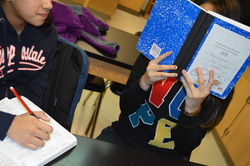When you’re teaching the human body systems, it can be fun to start from the outside and work your way in. After completing the Integumentary system, we liked to move in another layer, the muscular system. Here’s how we taught this lesson in our class – the kids REALLY enjoy throwing things at each other and it teaches them about voluntary and involuntary muscle control at the same time.
Sponge or Bellwork: Our lessons always start with a bell-work question or activity that gets kids thinking about the topic at hand. For example:
- Have students brainstorm in their groups the types of muscles of the body.
- Have students define voluntary and involuntary.
Let’s Explore: Have your students take notes on the muscular system, including how they work, involuntary and voluntary muscle action and types, and the different types of muscle cells: skeletal, smooth, and cardiac. Reinforce their knowledge by having them draw each type of muscle – our PowerPoint has real microscopic pictures of each type of muscle or you can integrate lab stations with muscle tissue slide samples and microscopes if you have them.
Once you’re done with notes, revisit the idea of voluntary vs. involuntary muscle actions and talk about the different types of muscles of the body that fit into each of those categories. Have students apply what they’ve learned to our “In a Blink Lab”. The lab is all about whether blinking is voluntary, involuntary, or BOTH types of muscle actions and there are three parts to the lab.
First, have students pair up. One student reads a passage from their notebook, doodles, or works on homework, while their partner counts how many times they blink NATURALLY in one minute. We found it easiest to have students busy doing something so they are distracted and won’t think about blinking. Upon completion of this activity, students find that blinking is a necessary activity that they don’t have to think about.
Did They Get It?: They should come to the conclusion that this is an INVOLUNTARY muscle action.
 Let’s Explore: Ready for chaos? The last activity involves throwing. Yep, we said throwing. Each student will take turns throwing a balled up piece of paper at their partner while they wear protective goggles or hold a piece of transparency paper or saran wrap in front of their face, each time marking in a table whether they blinked or not when the paper was thrown.
Let’s Explore: Ready for chaos? The last activity involves throwing. Yep, we said throwing. Each student will take turns throwing a balled up piece of paper at their partner while they wear protective goggles or hold a piece of transparency paper or saran wrap in front of their face, each time marking in a table whether they blinked or not when the paper was thrown.
Did They Get It?: Most students blink during this activity, reinforcing the fact that blinking is a reflex action that protects the eyes from foreign objects.
Explain It: Students record and analyze their data at the end of all of the trials and should come to the conclusion that blinking can be both involuntary and voluntary. Once all is said and done, students would work together on the extension activities and come together as a class to discuss.
Here’s a few extensions for this lesson:
- Have students complete the trials on their family for homework.
- Have students research disorders of the eye cause by not blinking.
- Have students make a list of other involuntary muscle actions and why they are important.
- Ask students to stand on their head (with support from a wall or other person) and drink water. Explain why the water still travels to their stomach.
Need to modify?
- Reduce the number of trials to be completed.
- Have a peer complete data tables for students that have executive function deficits.
- Create a template for recording data from their trials rather than having students complete the table in their notebooks.
It’s a great way to reinforce the different types of muscle actions and it gets the kids into quite a frenzy. And at the end of the period, you can have kids use their voluntary muscles to pick up all the trash and volunteer it to the recycling bin.
Inspire Students. Love Teaching.
We have everything you need to successfully teach life science and biology. Join over 85,000 teachers that are seeing results with our lessons. Subscribe to our newsletter to get a coupon for $5 off your first order!



Wow, this really looks engaging. I can’t wait to use this in Anatomy.
Thank You!